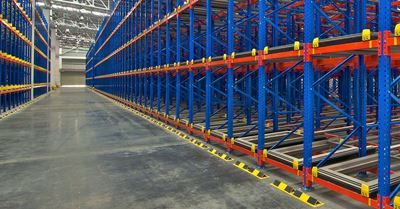Push Back Rack | Santa Barbara

Raymond West offers pushback rack in a variety of styles and capacities.
We are one of the largest industrial racking suppliers in the state.
Call us today at (805) 749-2777
What Is Push Back Racking?
Push back racking (also referred to pushback rack) is a high density pallet storage approach that configures pallet lanes from 2 to 6 units deep. Pallets rest on nested carts that travel up a modest gradient as pallets are added, or “pushed back” from the face of the rack.
When goods are subsequently pulled, the pallet immediately behind the first position pallet glides back down the incline to the nearest position.
Push Back Rack Advantages And Disadvantages
Pushback rack is perfect for certain operations, but isn’t suitable for every warehouse. Here are some of the benefits and drawbacks to consider.
Higher Density Storage
Since push back pallet racks can hold anywhere from 2-6 pallets in any given position, they can recover between 1-5 aisles, which represents an enormous chunk of warehouse space.
Less Forklift Travel
When aisle numbers are reduced, forklifts don’t have to make as many trips, increasing efficiency and reducing wear and tear on equipment. Reduced forklift movement also makes a safer environment within the warehouse. Fewer trips directly correlates to a lower number of accidents.
Greater Selectivity
Push back pallet racking provides an excellent mixture of selectivity and storage efficiency. Different from drive-in rack, where full storage bays are generally a single SKU, push back features instant access to a larger selection of pallet slots from the aisle.
LIFO Configuration
Dissimilar to pallet flow rack, which is a First In First Out (FIFO) type of system, push back rack is a Last In First Out (LIFO) style of approach. Last In First Out is not generally suitable for goods that are perishable, because products that are added early may sit for long stretches of time as goods are added and removed from the aisle.
How Does Push Back Racking Work?
Push back racks utilize a set of tracks sloping in the direction of the aisle and a collection of nested carts which move on these rails.
The first pallet is placed on the top cart by a forklift. When a new pallet is loaded, the forklift operator pushes the original pallet back and sets the next pallet on the second cart. The last pallet positioned in the lane sits on the tracks.
In the unloading process, shuttles loaded with pallets slide down the tracks. Lift truck drivers pull each pallet sequentially until the lane is exhausted, or add pallets, filling the lane back up.
Push Back Pallet Racking For Sale
For more information on push back racking options, contact a warehouse storage professional at Raymond West today. Raymond’s system design experts can help you find a system that is ideal for your operation.
Raymond West's Santa Barbara County service area includes Buellton, Carpinteria, Goleta, Lompoc, Santa Barbara, Santa Maria and all surrounding areas.
Raymond West | Santa Barbara Material Handling Equipment Supplier
Santa Barbara County, CA
(805) 749-2777
<

